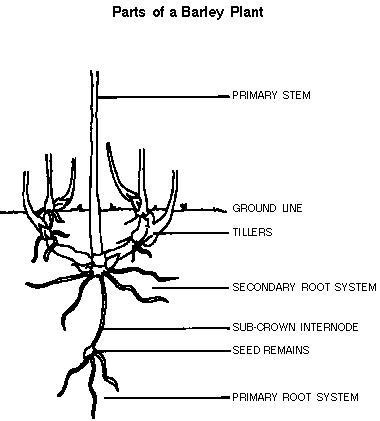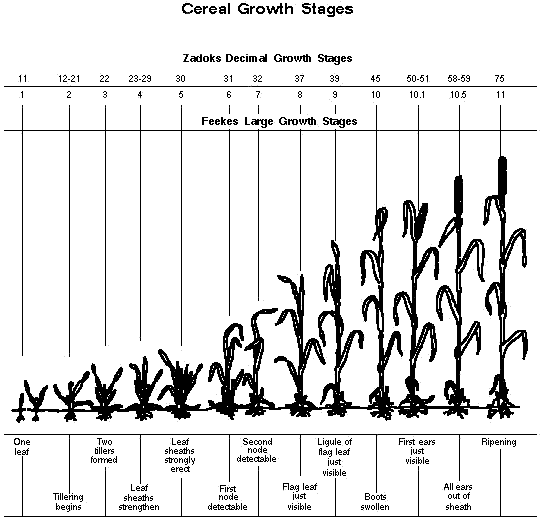| | Now that the seed is in the ground and germination is starting, an understanding of what is happening to the plant is essential for making management decisions. How the parts of the barley plant function and the processes that go on within the plant are called its physiology. Barley is a member of the grass family and is one of the "bunch" grasses. The bunch habit results from the development of buds near the base of the main stem that produce additional stems called tillers. Each plant develops two separate root systems. Primary roots develop from the seed and grow quickly, ensuring a moisture supply to the young plant even when the soil near the surface dries. Later, a secondary root system develops from a crown that forms just below the soil surface, which is the source of tillers as well as crown roots. The primary roots are joined to the crown by a sub-crown internode, a slender section of stem that carries moisture and nutrients to the developing plant, maintaining it until leaves and crown roots are well established.


The seedling stage is a critical period of growth and damage to the sub-crown internode from diseases or insects during this stage will weaken or kill the young plant. The length of this internode is determined by sowing depth, and the longer the internode, the greater the probability of damage from disease or insects. Shallow seeding into a firm, moist seedbed assures a short sub-crown internode and promotes the growth of healthy young plants.
The crown or secondary root system is responsible for supplying most of the plant's moisture and nutrient requirements. During unusually dry seasons, or with delayed seeding, the surface soil can become dry. If so, few or no tillers and crown roots develop. The main stems must produce heads and grain from moisture and nutrients supplied by the primary roots. When this happens, yields are low, even if the soil moisture is adequate when the heads are filling.
The Feekes scale of growth stages was developed for wheat but applies equally to barley up to the boot stage. In a typical season over much of Alberta the crop will be sown in early May. Completion of stage 1 will require about 6 to 12 days, and stages 2-5 an additional 5 or 6 weeks. The buds that develop into the above-ground plant parts form at the growing point during the late seedling stage. Therefore, plant development and potential yield is determined very early, i.e., by the fourth to fifth leaf stage. Damage to these buds during the seedling stage prevents normal growth, and weak seedlings cannot grow into healthy plants even under ideal growing conditions. However, the growing point remains below the soil surface until tillering is nearly complete. This delayed emergence of the growing point protects it from damage by frost, wind, hail, and some insects, and allows plant recovery if the leaves are damaged. Damage to leaf tissue at this early stage has little or no direct effect on yield, however, some maturity delay is likely.

Stages 6 to 10 proceed very quickly in late June or early July, and flowering in barley takes place in the boot at our latitudes. Grain filling and maturity will be completed during August over most of the province.
The actual time from seeding to maturity will depend on temperature, light, nutrition, moisture and variety. Mid-season varieties like AC Metcalfe and AC Lacombe can mature in as few as 80 days, or require as many as 120 days from seeding. They will normally mature in 90 to 95 days in the south, and about 100 to 105 days in central and northern areas.
Yield is the product of the following three components: number of heads per unit area; number of seeds per head; seed weight.
Under optimum growing conditions each plant will produce a large number of tillers and long heads with plump seeds. Consequently, yield is fairly constant over the range of recommended seeding rates. Thin seeding results in heavy tillering and large heads and seeds. Conversely, thick seeding results in reduced tillering and smaller heads and seeds. Heavy seeding promotes somewhat earlier maturity but may contribute to lodging, and to lower yields where moisture is limited.
Environmental stresses during the growing season can reduce yields by affecting any or all of these three components. Effects of stress during the flowering stage are most severe. Even moderate drought during this stage can result in appreciable yield loss. |
|